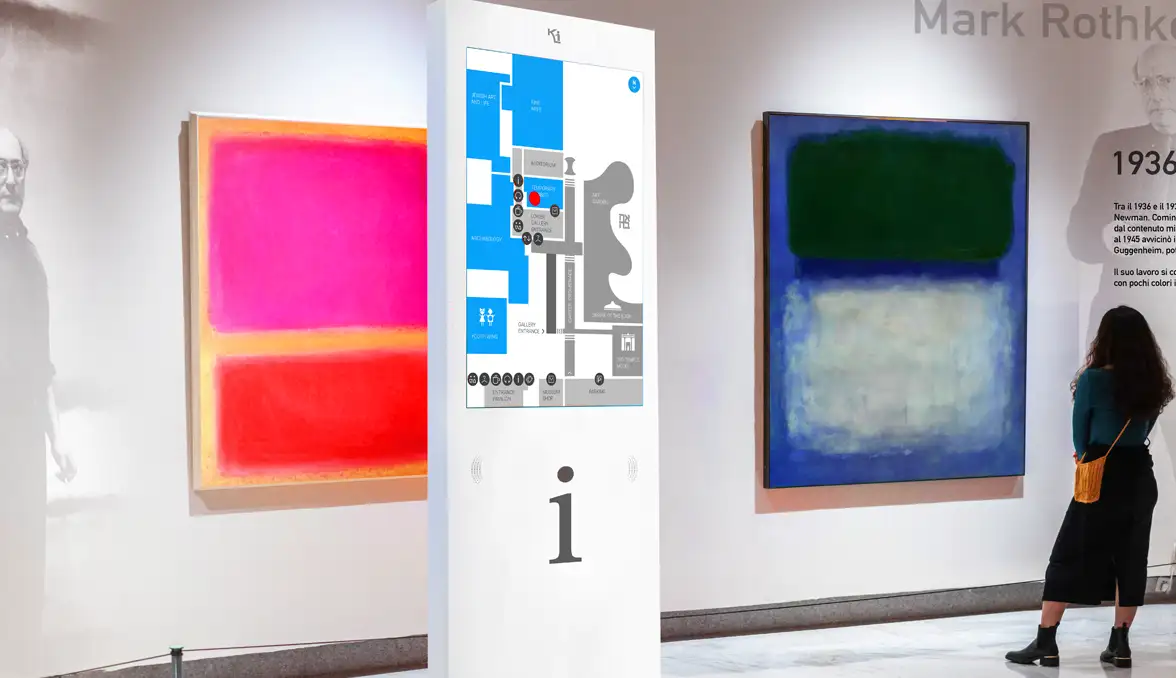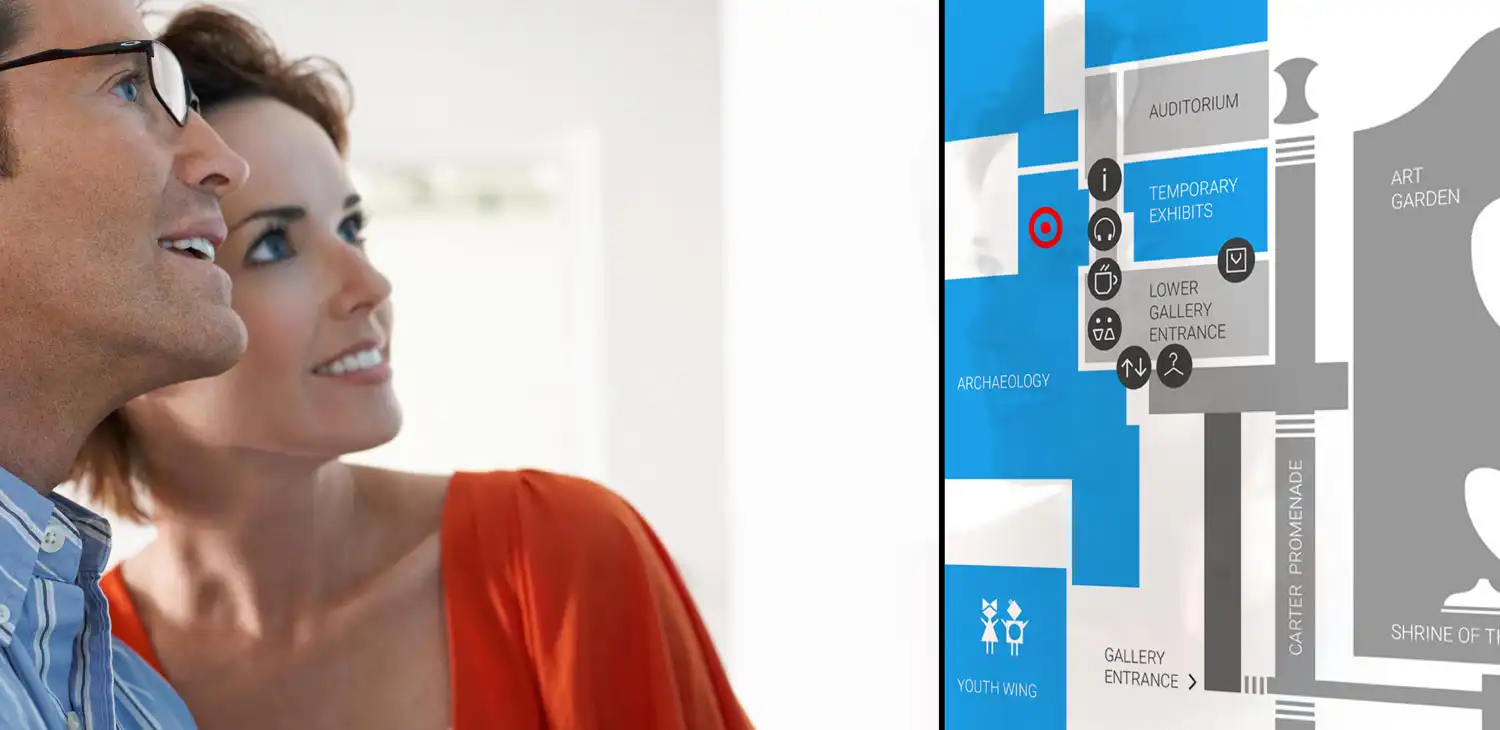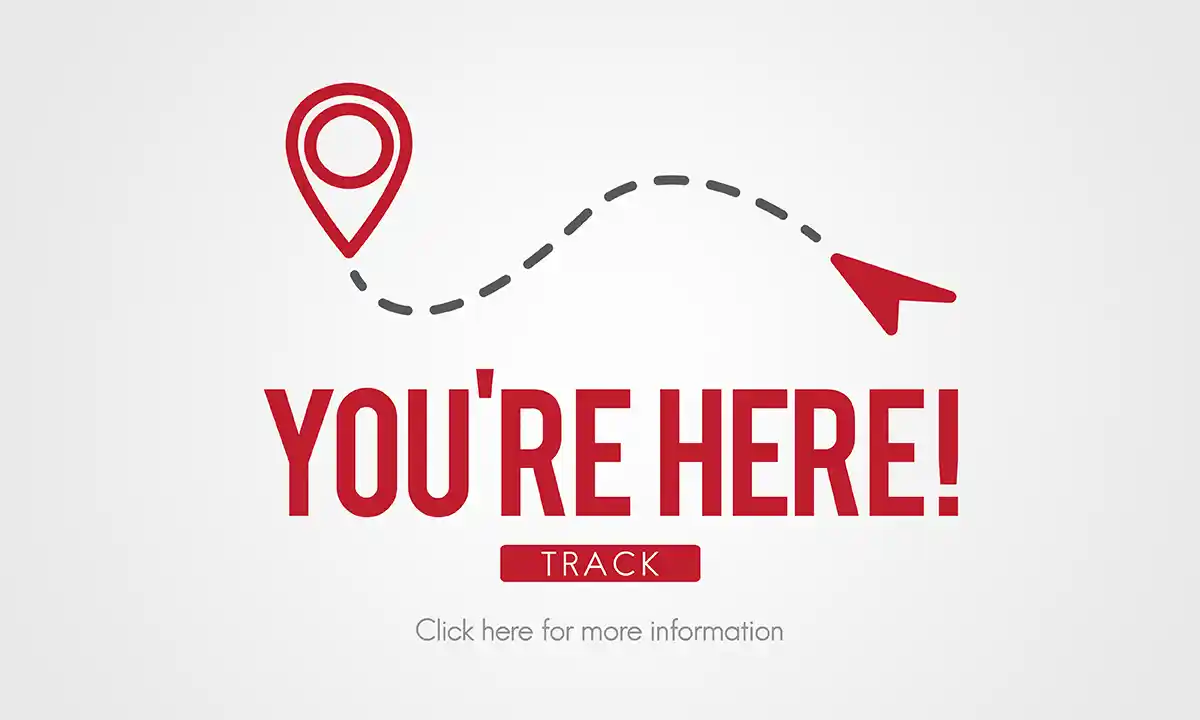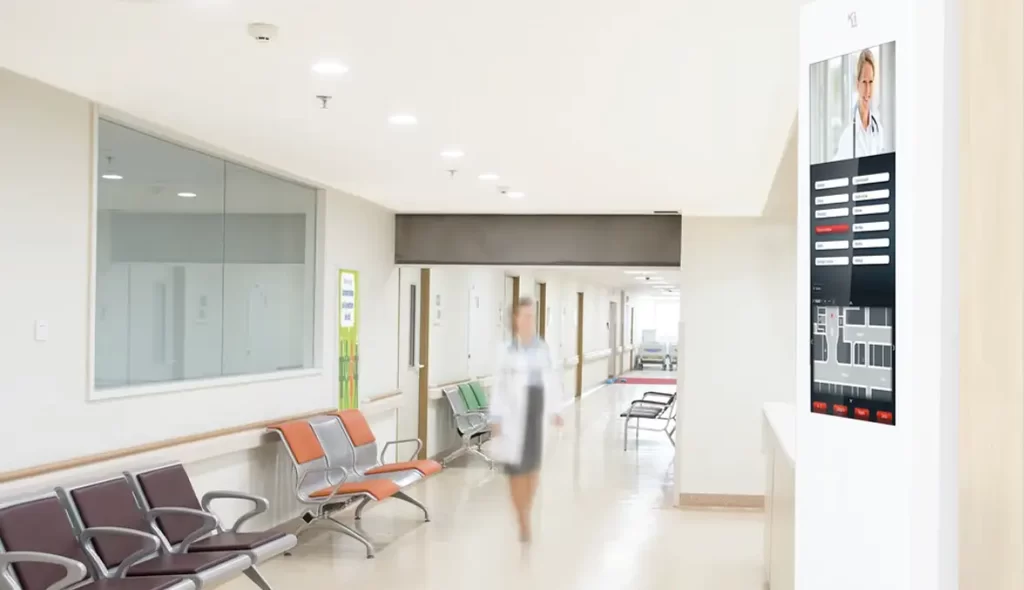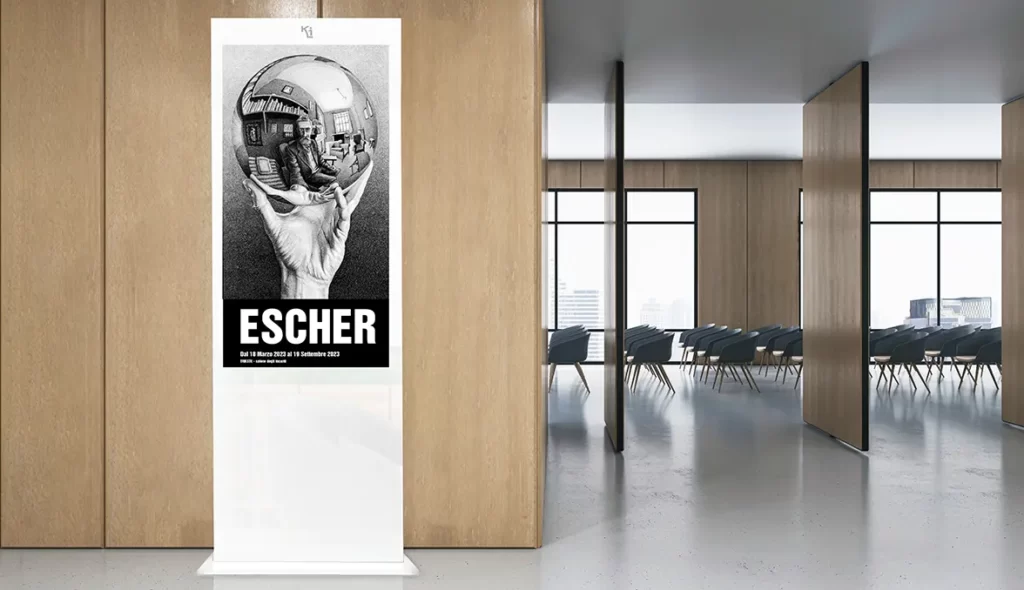A visit to a museum can be a fascinating and enriching experience, but also stressful and frustrating if you are unable to find your way around its rooms. In this context, a wayfinder system represents an effective solution for providing visitors with precise and detailed information on how to reach the various exhibitions and the works of art in the museum.
What is a wayfinder system for museums?
Wayfinders are advanced signage systems that allow visitors to move around a museum easily and intuitively, eliminating the risk of getting lost or losing interest in the visit and at the same time finding what they want inside. fast and personalized way.
A wayfinder system ranks among the most intriguing digital signage applications, due to the kind of interactive experience it is able to offer to visitors in general. It usually consists of a series of touch screens or multimedia totems placed at strategic points within the museum, providing information on the exhibits and their locations, as well as future exhibitions and museum activities.
The wayfinder system is the result of integrating technologies and software in order to help museum visitors find their way inside the building and orient themselves during the visit.
Usually these digital orientation maps are designed to work on large touchscreen totems, and are the result of a careful planning activity that puts the visitor at the center of the museum experience.
The importance of wayfinders for museums.
A well-designed wayfinder system is a key element in ensuring that visitors fully enjoy their visit to the museum.
Below are 7 major benefits of using wayfinders in museums:
Orientation: The first and most obvious benefit of using wayfinders in museums is improved visitor orientation. An effective digital signage system can guide visitors through the exhibits, providing indications on the artworks on display and the location of the various rooms. But not only works of art: also service points, lifts, bars and benches for sitting, emergency exits are some of the information made available.
Enhanced visitor experience: Wayfinders not only help visitors find their way around the museum, but also enhance their visitor experience. This is especially important for visitors who have physical limitations or disabilities, as wayfinders can help locate accessible areas easily and plan their visit more efficiently.
Increased Visitor Engagement: Wayfinders can also increase visitor interest in the museum and the artwork on display. A well-designed digital signage system can provide interesting information about exhibits and exhibits, grabbing visitors’ attention and creating an engaging and informative experience.
Orderly flows: Wayfinders can also help museum staff manage the flow of visitors, avoiding overcrowding in the most popular exhibits and allowing visitors to proceed and get directions independently.
Accessibility: The signage and map can help visitors with disabilities or mobility impairments navigate the museum and locate accessible areas.
Promotion: A well-designed map and signage can also promote awareness of and interest in the museum and the artworks on display, providing detailed information about the history, culture and art.
Efficiency: A digital map with clear, well-placed signage can also improve museum efficiency by reducing the time visitors spend trying to find their way around and increasing the proper flow of visitors through the various sections of the museum.
The advantages for a museum of installing a wayfinding system are many. The advantages for a museum of installing a wayfinding system are many. In fact, easy digital orientation signage relieves internal staff from providing information, thus allowing them to carry out often more important safety tasks.
In addition, a wayfinder system can be used to gather information about visitors and their visiting habits. This data can be used to improve the design of the museum’s exhibitions and activities and to create personalized offers for visitors.
Finally, a wayfinder system can improve museum safety and in the event of an emergency or dangerous situation, navigation systems can be used to better direct people towards a rapid evacuation of the buildings.
How to build a wayfinder system.
Building a digital wayfinder system can be a complex process, requiring collaboration between professionals from different disciplines, such as technology experts, architects, user experience designers, content specialists, and museum staff.
However, here are 6 general steps to creating a digital wayfinder system:
- Requirements analysis: Before starting the design, it is important to understand the needs of museum visitors and areas that may be problematic for navigation. An analysis should be made of areas of the museum where visitors may have difficulty finding their way, such as narrow corridors, areas with many works of art, or temporary exhibition halls.
- Planning: Once the requirements are understood, a plan for the wayfinder system should be developed. This could include choosing which technologies to use, building a list of required features, defining user interactions, and planning your development budget and timeline.
- User Experience Design: The next step is user experience design. An intuitive and easy-to-use design should be created for the user, allowing him to find his way efficiently and access the required information. Particular attention should be paid to designing the user interface and creating clear, easy-to-read maps.
- Software Development: Once the design is complete, one should proceed with the software development. This could include the development of mobile applications, web-based navigation software, positioning sensors or audio guide systems. This could include the development of mobile applications, web-based navigation software, positioning sensors or audio guide systems.
- Testing and launching: After developing the software, a series of tests should be performed to ensure that it works properly and meets the set requirements. Subsequently, the wayfinder system is expected to be launched and made available to museum visitors. You should also plan to train museum staff to ensure they are able to answer visitor questions and resolve any technical issues.
- Monitoring and improvement: Finally, it is important to monitor the wayfinder system and collect feedback from visitors. This could help identify any problems or difficulties navigating the museum and implement changes to improve the visitor experience.
Design and user experience of a wayfinder system
The design of a wayfinder system is a key aspect to ensure a comfortable and satisfying experience for museum visitors. A well-designed wayfinder system must blend harmoniously with the museum’s architecture, making navigation more intuitive and smoother.
First, it is important that the design of the wayfinder system is consistent with the style and aesthetics of the museum building. The wayfinder system must respect the architectural characteristics and design elements of the building, in order to integrate seamlessly with the surrounding environment.
This can be achieved through the use of colours, shapes and materials which harmonize with the architecture of the museum.
Furthermore, the wayfinder system must be designed to guide visitors in a clear and intuitive way through the museum’s visit itinerary. To this end, the system must provide for the use of clear and easily recognizable signals, such as pictograms and symbols, to indicate the different paths and areas of the museum.
It is also important that the signs are placed at an adequate height, so that they are easily visible to visitors at any point along the tour route.
Another key aspect of the wayfinder system’s design is its integration with the museum spaces. For example, the wayfinder system can be integrated with orientation signs on the walls or floors of the museum, so as to create a continuous and coherent visit path.
Furthermore, the wayfinder system can be integrated with other architectural structures of the museum, such as exhibition halls, relaxation areas and toilets, in order to facilitate visitor navigation.
Inevitably, the design of a wayfinder system must also include the flexibility and customization of maps and labels, given that the intended uses can change over time or the works of art can be moved from one room to another.
To adequately cater to each user, the wayfinder system must be designed in such a way that it can be adapted to the different needs of visitors, based on their language, culture and abilities.
This can be achieved through the use of multilingual signage, internationally recognized pictograms, typography and symbology, and accessibility systems for visitors with disabilities.
Being a digital product, it is therefore necessary to give due importance to user experience.
UX design is a critical aspect in developing a digital art map, and as we know, a well-designed product not only looks good, but also provides a seamless and enjoyable experience for users. It is essential that the interface on the digital totem has consistent and intuitive navigation, that is easy to use and understand.
A defect that can be found, for example, in those who have chosen to use a mobile app on a totem is the use of a user interface with a navigation menu that is not suitable for large format monitors and therefore not suitable for consultation by visitors.
Let’s not forget that to provide a pleasant browsing experience, you should consider conducting tests and collecting visitor feedback in order to continuously improve the product. This is the way to make a really usable and pleasant product.
How much does it cost to build a wayfinder system for a museum?
The cost of building a wayfinder system for a museum can vary greatly depending on the complexity of the project and the specific needs of the museum.
There are many variables that can affect the cost of the system, including the number of waypoints, the type of hardware and software used, the type of signage, the degree of customization required, and the cost of design and implementation services.
However, to give a general idea of cost, wayfinder projects can start from a few thousand euros for a basic system up to tens of thousands or even hundreds of thousands of euros for more complex and customized projects.
In any case, the cost of the wayfinder system should be viewed as a long-term investment for the museum, as it can enhance the visitor experience and allow the museum to communicate more effectively with the public, thus increasing interest and audience engagement.
Kiosk Wayfinder: the ideal digital map.
Kiosk Wayfinder is a complete digital signage solution that performs the function of an interactive map, thanks to a touchscreen totem with integrated software. A system developed to be suitable for various public contexts, as also explained on the MDPI scientific portal, with the aim of providing users with intuitive information on their current position and on the routes to reach a specific destination.
The tool is designed to be placed in specific areas of the museum to allow visitors to access information about the works of art, navigation paths and indications on activities within the museum. A studied and perfected tool, capable of responding effectively to the typical needs of a museum.
Kiosk Wayfinder, in particular, can offer a number of advantages over other wayfinding solutions, including:
- Visibility: being a physical device, the totem with Kiosk Wayfinder can be placed in a highly visible position within the museum, making it easy for visitors to locate.
- Interactivity: Kiosk Wayfinder has an interactive user interface, which allows visitors to interact with the system and access the information they need.
- Customization: Kiosk Wayfinder is customized according to the specific needs of the museum, such as the design, the information provided and the languages available.
- Reliability: Kiosk Wayfinder is installed on a self-contained and reliable device, which does not require the use of a personal mobile device.
